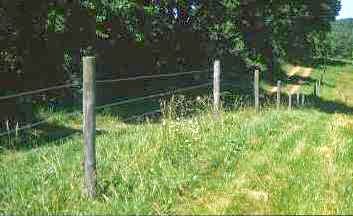 |
| Woven Wire Fencing |
Woven Wire Fence : To best utilize this fence, it needs to have a brace that uses two 8-inch diameter posts and a 4-inch diameter cross brace at each end. Posts between braces should be steel "T" posts alternated with 4-inch diameter pressure treated wood posts. All posts are spread 12 feet apart with one strand of barbed wire at the top. Woven wire fences are very effective when used with a barb wire or electric strand at the top or inside the enclosure near the middle of the woven wire. The advantage of a woven wire fence is its effectiveness as a visual barrier for the animals. Woven wire is best used as a perimeter fence.
 |
| Barbed Wire Fencing |
Barbed Wire Fence: This fence is similar to the woven wire fence, the exception to this is that five strands of barb wire are used instead of the woven wire and single barbed wire fence. Barb Wire is used in many places and many ways. This close up of a barb wire fence shows why it is useful as a livestock deterrent.While barb wire is very effective alone, its efficiency as an electric fence is poor because it looses a large amount of energy through the barbs.
 |
| High Tensile (non-electric) Fencing |
High Tensile (non electric): Eight strands of 12.5-gauge High Tensile Wire are used on 4 inch treated wooden posts spaced 20 feet apart. To brace this fence use 3- 8 inch posts and 2-4 inch cross brace posts. Tension can be taken care of by using springs and ratchets. To save 4 cents per foot, posts can be spaced 30 feet with 2 stay rods placed in between posts. Non-electric fences are higher maintenance as animals can push up against and through them. More strands are also needed to confine livestock. A combination of electric and non-electric strands is superior and more widely used.
 |
| High Tensile (electric) Fencing |
Hight Tensile (electric): Use five strands of 12.5 gauge high tensile fence. Three alternating wires will be electrified and the other two will be grounded wires. Brace corners and wire tension are the same as the High Tensile (non electric) Fence. Steel "T" posts spaced 25 feet apart are used on this fence.
 |
| Calf near temporary fencing |
Temporary Fences: Using polytape for a temporary fence is effective because of the high visibility. Polytape is plastic and aluminum or steel woven together to create an electric flow. Depending on size or brand there are normally eight to 10 metal strands.
Fencing Costs
Perimeter Fencing Costs
|
Item
|
Woven Wire
|
Barbed Wire
|
High tensile
(non electric) 8 strand
|
High tensile
(electric)
5 strand
|
| Estimated useful life (yr.) |
20
|
20
|
25
|
25
|
| Average annual maintenance (% of initial cost) |
8%
|
8%
|
5%
|
5%
|
| Depreciation |
$99
|
$81
|
$59
|
$37
|
| Interest on investment |
$79
|
$65
|
$59
|
$37
|
| Maintenance |
$159
|
$129
|
$74
|
$46
|
|
Total Cost per Year
|
$338
|
$274
|
$193
|
$121
|
|
Total Cost per Foot/Year
|
$0.26
|
$0.21
|
$0.15
|
$0.09
|
* Annual average ownership cost by fence type (Based on a 1,320 ft. fence)
Interior Fencing Costs
|
Item
|
Amount Needed
|
Cost Per Unit
|
Total Cost
|
| Wood Post (4 inch diam) |
2
|
$9.30
|
$19
|
| Fiberglass posts (3/8" x 4') |
33
|
$1.59
|
$52
|
| Insulators |
2
|
$0.80
|
$2
|
| Post Clips |
42
|
$0.25
|
$11
|
| Polywire |
1320 ft.
|
$0.026
|
$34
|
| Energizer (priced over 4 yrs) |
1/4
|
$200
|
$50
|
| Cut-out switch |
1
|
$9
|
$9
|
| Grounding/Lightning Rod |
4
|
$9
|
$36
|
| Labor estimate |
2 hrs
|
$13
|
$27
|
|
Total
| | |
$240
|
|
Total per foot
| | |
$0.18
|
| Cost of adding 1 strand of polywire (wire, clips, insulators) |
$35 or .03 per ft
|
*Based on a 1,320 ft. fence
Reference: Estimated Costs For Livestock Fencing, Iowa State University Cooperative Extension Service, 2005
*Pasture and fencing information was developed by Michelle and Jeremy Sweeten.






company you can be confident that JPR fence installations will be of high quality and will protect your site from re-incursion by European protected species.fence cost
ReplyDelete